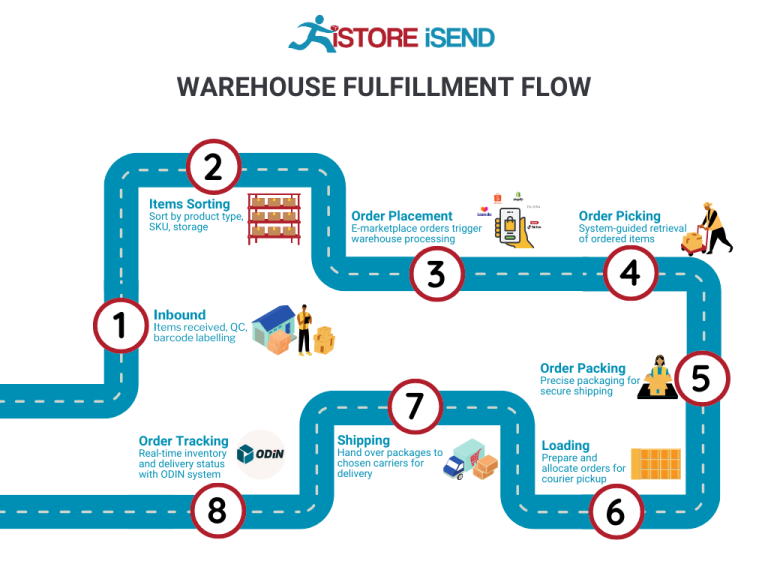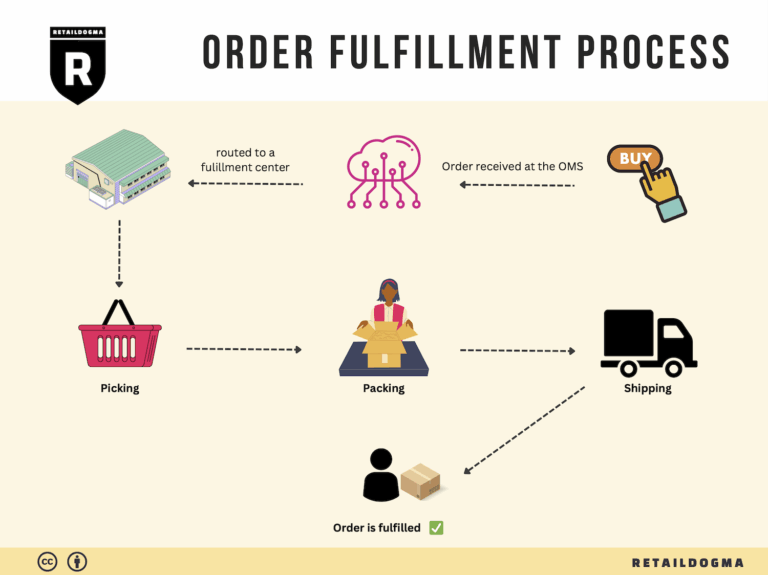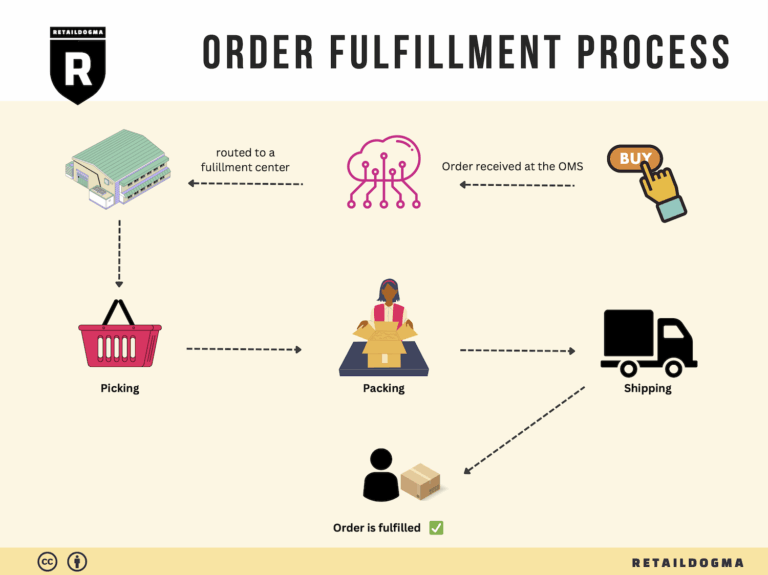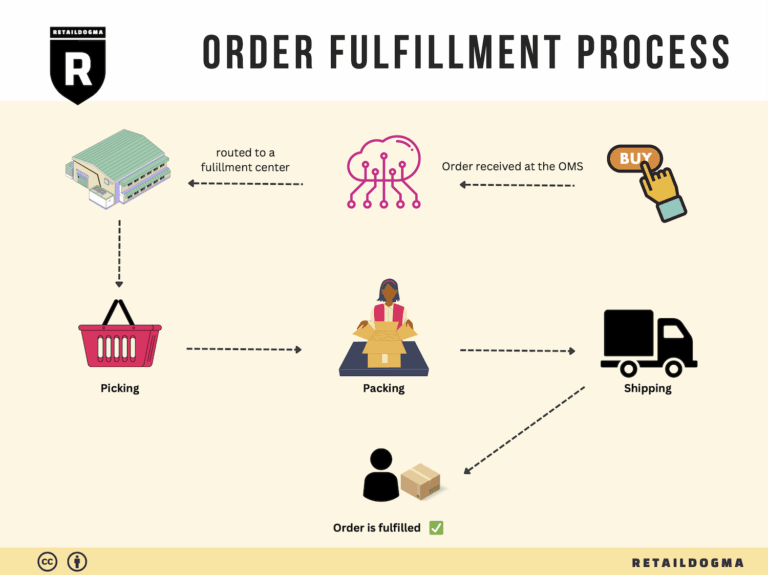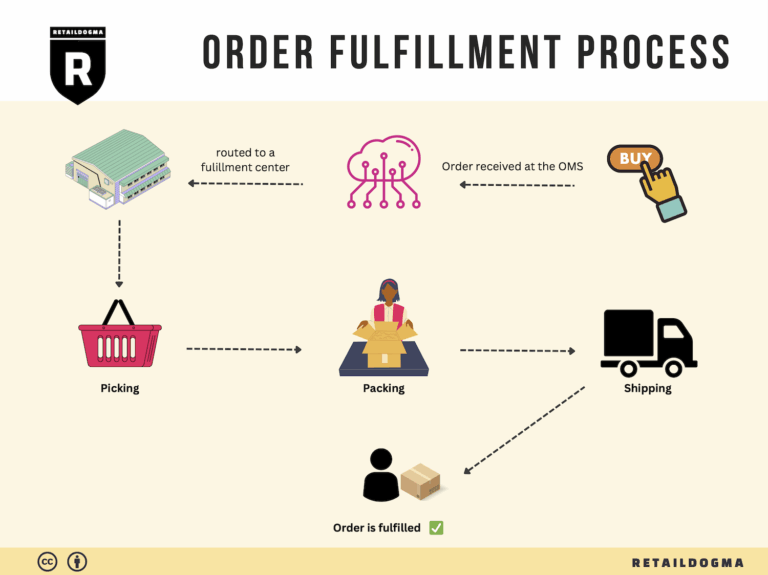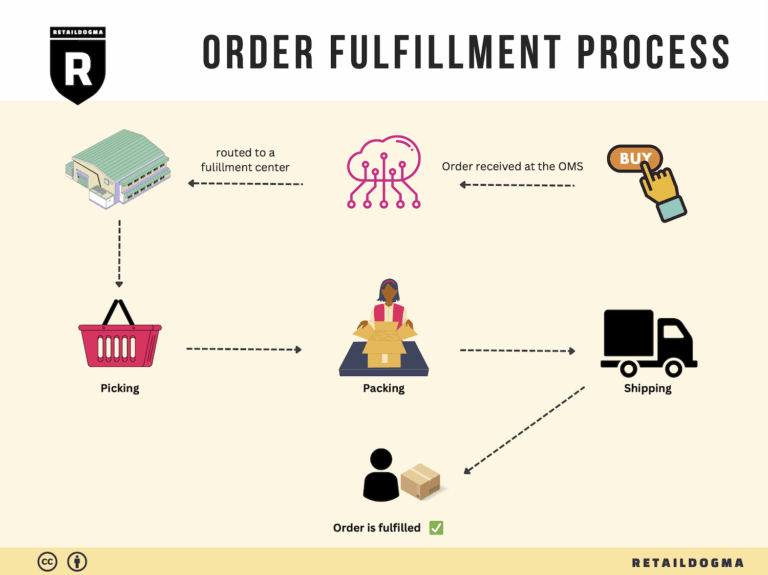Ecommerce Fulfillment Services: The Ultimate Guide (2025)
What is E-commerce Fulfillment? An Introduction for Growing Businesses
Understanding E-commerce Fulfillment: A Critical Component for Growth
As an e-commerce business owner, you may have experienced the growing pains of managing your logistics. The excitement of increasing sales can quickly turn into a headache when it comes to packing and shipping orders. This is a common pain point for many entrepreneurs: the overwhelming nature of fulfillment can distract you from focusing on your core business activities, such as marketing and product development.
Fulfillment, at its core, is the process of getting a product into the hands of a customer. It encompasses everything from receiving inventory and storing products to picking, packing, and shipping orders. As your business expands, understanding the intricacies of fulfillment becomes essential for maintaining customer satisfaction and operational efficiency.
In this guide, we will explore various fulfillment models that can help streamline your logistics. You’ll learn about Third-Party Logistics (3PL) providers, who manage inventory and shipping on your behalf, and Fulfillment by Amazon (FBA), a popular option that leverages Amazon’s extensive logistics network. Each model has its own set of advantages and challenges, and we will break down what works best for different types of businesses.
Additionally, we’ll cover the core services involved in e-commerce fulfillment, such as inventory management, order processing, and shipping. Knowing these services will help you assess what your business needs and how to align with a fulfillment partner that can deliver those services effectively.
Choosing the right fulfillment partner is crucial for your business’s growth. We will provide actionable tips on what to consider when selecting a logistics provider, including factors like service reliability, technology integration, and customer service capabilities. Pricing is another key aspect we’ll address, as understanding the cost structures associated with different fulfillment options will empower you to make financially sound decisions.
The goal of this guide is to equip you with the knowledge and tools necessary to make informed choices about your logistics strategy. By the end, you will have a clear understanding of the fulfillment landscape and how to navigate it, allowing you to focus on what you do best—growing your business.
What You’ll Learn In This Guide
- What is E-commerce Fulfillment? An Introduction for Growing Businesses
- The Order Fulfillment Process: From ‘Buy’ Button to Customer’s Door
- Comparing Fulfillment Models: In-House vs. 3PL vs. Dropshipping
- A Deep Dive into Amazon FBA: Pros, Cons, and Who It’s For
- Core Services Offered by Fulfillment Centers
- How to Choose a Fulfillment Partner: A 6-Point Checklist
- Understanding Fulfillment Pricing: A Breakdown of Common Fees
- Frequently Asked Questions (FAQs) about Fulfillment
- Conclusion: Is Outsourcing Fulfillment the Right Move for Your Business?
- Important Disclaimer
The Order Fulfillment Process: From ‘Buy’ Button to Customer’s Door
1. Receiving Inventory
The order fulfillment process begins with receiving inventory at the fulfillment center, such as Amazon’s ONT2 facility in San Bernardino, California. This step involves the acceptance of goods from suppliers, where the inventory is checked against purchase orders to ensure accuracy in quantity and quality.
Importance: Proper receiving is critical as it lays the foundation for effective inventory management. Any discrepancies at this stage can lead to stockouts or overstock situations, impacting sales and customer satisfaction.
Key Term: SKU (Stock Keeping Unit) – A unique identifier assigned to each product, which facilitates tracking and management of inventory levels. By scanning SKUs upon receipt, operations can quickly update their inventory systems, ensuring that products are accurately accounted for and ready for storage.
2. Warehouse Storage
Once inventory is received and verified, it is placed in the warehouse for storage. This process involves organizing products in a manner that maximizes space while ensuring easy access for future order fulfillment. The ONT2 facility, for example, employs advanced technology and robotic systems to enhance storage efficiency and space utilization.
Importance: Effective warehouse storage is crucial for minimizing retrieval time during the picking process. A well-organized warehouse reduces the risk of errors and improves overall operational efficiency.
Key Term: FIFO (First In, First Out) – A method of inventory management where the oldest stock is sold first. This approach is particularly important for perishable goods but is beneficial in maintaining freshness and reducing waste for all types of inventory.
3. Order Picking
The next step is order picking, where items are selected from the warehouse based on customer orders. This process typically utilizes pick lists, which are generated from incoming orders and guide warehouse staff to the specific locations of the products needed.
Importance: Efficient order picking directly impacts fulfillment speed and accuracy. A streamlined picking process helps to ensure that orders are fulfilled quickly, thereby enhancing customer satisfaction.
Key Term: Pick Lists – Documents or digital records that specify the items and quantities needed for each order. They assist workers in locating items swiftly and accurately, reducing the chances of errors and improving throughput.
4. Order Packing
After items are picked, they move to the packing stage. During this step, products are carefully packed into boxes or envelopes, ensuring they are protected for transit. This process often includes weighing packages, applying shipping labels, and including necessary documentation (like invoices).
Importance: Proper packing is essential for preventing damage during shipping and ensuring compliance with shipping regulations. Additionally, well-packed orders enhance the unboxing experience for customers, which can improve brand perception and encourage repeat business.
Key Term: Packaging Materials – Various materials used to protect products during shipping, including bubble wrap, packing peanuts, and sturdy boxes. Choosing the right packaging materials can significantly reduce the risk of damage and returns.
5. Shipping & Delivery
The final step in the order fulfillment process is shipping and delivery. Once packages are packed, they are handed over to shipping carriers, who transport them to the customer’s address. This process involves tracking shipments and managing logistics to ensure timely delivery.
Importance: The shipping and delivery phase is crucial as it directly affects customer satisfaction. Timely and reliable delivery can enhance customer loyalty, while delays or issues can lead to dissatisfaction and negative reviews.
Key Term: Last Mile Delivery – The final step of the delivery process where the package is transported from a transportation hub to the final delivery destination. Optimizing last mile delivery is essential for improving delivery speed and customer experience, especially in e-commerce.
By understanding and optimizing each step of the order fulfillment process, e-commerce businesses can significantly enhance their operational efficiency, reduce costs, and improve customer satisfaction. This holistic approach is vital for scaling operations and maintaining a competitive edge in the marketplace.
Comparing Fulfillment Models: In-House vs. 3PL vs. Dropshipping
Fulfillment Model Comparison
| Model | Who Handles Inventory | Best For (Business Stage) | Key Advantage | Key Disadvantage |
|---|---|---|---|---|
| In-House Fulfillment | The business itself | Established businesses | Full control over inventory and processes | High overhead costs and complexity |
| Third-Party Logistics (3PL) | A third-party provider | Growing businesses | Scalability and expertise in logistics | Less control over inventory and processes |
| Dropshipping | Supplier | Startups and small businesses | Low startup costs and inventory risk | Lower profit margins and potential quality issues |
In-House Fulfillment
In-house fulfillment refers to when a business manages its own storage, picking, packing, and shipping processes. This model is typically adopted by established businesses that have the resources and infrastructure to support the logistics of order fulfillment. One of the primary advantages of in-house fulfillment is the level of control it offers. Businesses can manage their inventory directly, ensuring that they have optimal stock levels and can respond quickly to customer needs. Additionally, having complete oversight of the fulfillment process allows for streamlined operations and potentially enhanced customer service.
However, the key disadvantage of in-house fulfillment is the high overhead associated with maintaining a warehouse and staff. Businesses must invest in real estate, technology, and labor, which can be a significant financial burden, especially for smaller companies. Moreover, as demand fluctuates, businesses may struggle with scaling their operations efficiently. Managing logistics in-house can also divert focus from core business activities, such as marketing and product development, potentially stunting overall growth.
Third-Party Logistics (3PL)
Third-party logistics (3PL) involves outsourcing the entire fulfillment process to a specialized logistics provider. This model is particularly well-suited for growing businesses that are scaling rapidly and need to focus on their core competencies. 3PL providers offer expertise in logistics, including inventory management, shipping, and warehousing, which can lead to significant operational efficiencies. They often have established networks and technology that can enhance shipping speed and reliability, allowing businesses to provide better service to their customers.
The primary disadvantage of using a 3PL is the loss of direct control over the fulfillment process. Businesses must rely on the provider’s systems and processes, which can lead to inconsistencies in service quality. Additionally, while 3PLs can offer scalability, they often come with complex fee structures that can impact profit margins. Businesses may find themselves tied to long-term contracts or minimum volume commitments, which can be challenging to navigate, especially if demand fluctuates unexpectedly.
Dropshipping
Dropshipping is a fulfillment model where the retailer does not keep the products it sells in stock. Instead, when a retailer sells a product, it purchases the item from a third-party supplier who ships it directly to the customer. This model is especially appealing for startups and small businesses because it requires minimal upfront investment in inventory. Retailers can offer a wide variety of products without the financial risk associated with unsold stock, making it an attractive option for those testing new markets or products.
Despite its advantages, dropshipping comes with several key drawbacks. One of the most significant is the lower profit margins, as retailers often pay a premium to suppliers for the convenience of not holding inventory. Additionally, quality control can be a challenge; since retailers do not handle the products, they may struggle with customer complaints regarding product quality or shipping delays. The reliance on suppliers can also lead to stock shortages and fulfillment errors, which can tarnish a retailer’s reputation and customer satisfaction.
In conclusion, each fulfillment model has its unique benefits and challenges, making it essential for e-commerce business owners to carefully consider their specific needs and growth strategies when selecting a fulfillment solution. By understanding the nuances of in-house fulfillment, 3PL, and dropshipping, businesses can make informed decisions that align with their operational capabilities and long-term objectives.
A Deep Dive into Amazon FBA: Pros, Cons, and Who It’s For
Understanding Fulfillment by Amazon (FBA)
Fulfillment by Amazon (FBA) is a service that allows e-commerce sellers to store their products in Amazon’s fulfillment centers. Amazon takes care of the storage, packaging, shipping, and customer service for these products. When a customer orders a product, Amazon handles the entire process, ensuring prompt delivery and customer satisfaction. This service provides sellers with the ability to reach Amazon’s vast customer base while minimizing their own logistical burdens.
How FBA Works
-
Inventory Management: Sellers ship their products directly to Amazon’s fulfillment centers, such as the ONT2 center in San Bernardino, California. Once the products arrive, Amazon manages the inventory, tracking stock levels, and handling storage.
-
Order Processing: When an order is placed, Amazon picks, packs, and ships the products on behalf of the seller. This is facilitated by Amazon’s sophisticated logistics network, which includes advanced technology and automated systems to enhance efficiency.
-
Customer Service: Amazon also manages all customer service inquiries related to FBA orders, including returns and refunds, allowing sellers to focus on growing their businesses.
-
Prime Eligibility: Products fulfilled through FBA are eligible for Amazon Prime, which can significantly enhance visibility and sales potential due to the appeal of fast, free shipping for Prime members.
Pros of Using FBA
-
Prime Eligibility: Products in FBA are automatically eligible for Amazon Prime. This boosts visibility and can lead to increased sales, as Prime members often prefer products that offer free two-day shipping.
-
Customer Trust: Leveraging Amazon’s trusted brand can enhance customer confidence. Buyers are more likely to purchase from sellers using FBA due to Amazon’s reputation for excellent service and reliability.
-
Multi-Channel Fulfillment: FBA allows sellers to fulfill orders not only from Amazon but also from other sales channels, such as eBay or their own websites. This flexibility can streamline operations for businesses selling across multiple platforms.
-
Scalability: FBA enables businesses to scale quickly without the burden of managing logistics. As order volumes increase, sellers can send more inventory to Amazon without needing to expand their own warehousing capabilities.
-
Time Savings: By outsourcing fulfillment to Amazon, sellers can save considerable time and effort that would otherwise be spent on packing and shipping products. This allows them to concentrate on marketing and growing their business.
Cons of Using FBA
-
High Fees: FBA comes with various fees, including storage fees for inventory and fulfillment fees based on the size and weight of products. These costs can accumulate and affect profit margins, particularly for low-cost items.
-
Strict Inventory Rules: Amazon has stringent policies regarding inventory management, including requirements for packaging, labeling, and even restrictions on certain products. Sellers must adhere to these guidelines to avoid penalties or disruptions.
-
Commingling Risks: FBA products may be commingled with inventory from other sellers, which can lead to complications in tracking and returns. If a customer receives a damaged or incorrect item, it can reflect poorly on the seller, even if the issue originated from another seller’s inventory.
-
Limited Control: By outsourcing fulfillment, sellers relinquish some control over the customer experience. Issues such as shipping delays or inventory mismanagement can impact seller ratings and reviews.
-
Complex Returns: While Amazon handles returns, the process can be complicated for sellers, especially if they need to manage their inventory levels closely. Returned items may not always be in resalable condition, leading to potential losses.
Who is FBA Best For?
FBA is particularly beneficial for:
-
Small to Medium-Sized Businesses: Companies that lack the resources or infrastructure to manage their own logistics can leverage FBA to efficiently scale their operations.
-
Sellers with High Sales Volumes: Businesses with high sales volumes can benefit from the reduced shipping costs and increased visibility that come with Prime eligibility.
-
E-commerce Entrepreneurs: New sellers entering the market can use FBA to establish credibility and streamline the process of getting their products to customers without the complexities of fulfillment.
-
Multi-Channel Retailers: Businesses that sell on various platforms can utilize FBA to centralize their inventory management and fulfillment processes, simplifying operations.
-
Businesses Selling Low-Margin Products: For sellers who offer low-cost items, FBA can provide competitive shipping solutions that might be difficult to achieve independently.
Conclusion
Fulfillment by Amazon offers a powerful solution for e-commerce sellers seeking to streamline their operations and expand their reach. While there are notable advantages, such as Prime eligibility and customer trust, potential drawbacks like high fees and strict inventory management must be carefully considered. Ultimately, FBA is best suited for sellers who can leverage its strengths while managing its challenges effectively. Understanding these dynamics can help business owners make informed decisions about whether to adopt FBA as a core component of their logistics strategy.
Core Services Offered by Fulfillment Centers
Inventory Management & Warehousing
Inventory management and warehousing are foundational services provided by fulfillment centers, designed to help e-commerce businesses efficiently store and manage their products. Fulfillment centers like ONT2 in San Bernardino, California, offer expansive warehouse spaces, often exceeding 1 million square feet, to accommodate a diverse range of products.
The benefits of effective inventory management are manifold. First, it enables businesses to optimize stock levels, ensuring that popular items are readily available while minimizing excess inventory that ties up capital. Advanced inventory tracking systems, often integrated with e-commerce platforms, allow businesses to monitor stock in real time, set reorder points, and forecast demand based on historical sales data. This leads to improved cash flow management and enhances customer satisfaction by reducing stockouts and backorders.
Moreover, warehousing services often include climate control and specialized storage solutions for various product types, which is crucial for businesses dealing with sensitive items such as electronics or perishable goods. By leveraging these services, e-commerce businesses can focus on growth and sales while leaving the complexities of inventory management to experts.
Pick and Pack Services
Pick and pack services are essential for the efficient processing of customer orders. This service involves selecting (picking) the right items from the warehouse and preparing them for shipment (packing). Fulfillment centers utilize sophisticated technology, including barcode scanning and automated systems, to streamline these processes, ensuring accuracy and speed.
The primary advantage of pick and pack services is the reduction in order fulfillment time. With a dedicated team and advanced technology, fulfillment centers can quickly assemble orders, often shipping them within 24 hours. This rapid turnaround is critical in today’s competitive e-commerce landscape, where consumers expect fast delivery.
Additionally, pick and pack services can be tailored to meet specific business needs, such as gift wrapping or including promotional materials, which enhances the customer experience. By outsourcing these tasks to a fulfillment center, e-commerce businesses can free up internal resources to focus on marketing and customer engagement while maintaining high service levels.
Kitting and Assembly
Kitting and assembly refer to the process of grouping individual items together into ready-to-sell packages or assembling products from multiple components. This service is particularly valuable for e-commerce businesses that offer bundled products or require assembly before shipping, such as furniture or electronics.
The benefits of kitting and assembly services are significant. First, they enable businesses to reduce the time and labor associated with preparing products for sale. By outsourcing these processes to a fulfillment center, businesses can avoid the logistical challenges of managing complex inventory and assembly lines in-house.
Moreover, kitting can enhance product appeal by creating attractive bundles that encourage higher average order values. For example, a business selling a camera could offer a kit that includes lenses, a bag, and a tripod, providing customers with a complete solution. This not only simplifies the purchasing process for customers but also increases revenue opportunities for the business.
Returns Management (Reverse Logistics)
Returns management, or reverse logistics, is a critical service offered by fulfillment centers that handles the process of returning goods from customers. This service encompasses everything from receiving returned items, inspecting their condition, restocking them, or processing them for disposal or refurbishment.
Efficient returns management is essential for e-commerce businesses, as it directly impacts customer satisfaction and loyalty. A smooth return process can significantly enhance the customer experience, encouraging repeat purchases. Fulfillment centers can implement automated systems to streamline returns, making it easy for customers to initiate returns and track their status.
Additionally, effective returns management allows businesses to analyze return data to identify trends, such as common reasons for returns or issues with specific products. This insight can inform product development and inventory decisions, helping businesses reduce return rates and improve overall product quality.
In conclusion, partnering with a fulfillment center like ONT2 provides e-commerce businesses with a suite of core services that streamline operations, enhance customer satisfaction, and ultimately support growth. By outsourcing inventory management, pick and pack services, kitting and assembly, and returns management, businesses can focus on scaling their operations while ensuring efficient and effective fulfillment processes.
How to Choose a Fulfillment Partner: A 6-Point Checklist
Location & Warehouse Network
Importance:
The geographic location of your fulfillment partner’s warehouses can significantly affect shipping times and costs. A partner with strategically placed warehouses can help you reach your customers faster, enhancing their experience and potentially increasing your sales.
Questions to Ask:
– Where are your warehouses located, and how many do you have?
– How do your locations align with my target market?
– What are your shipping times for different regions?
– Can you accommodate international shipping if needed?
Technology & Integrations
Importance:
In today’s fast-paced e-commerce environment, technology plays a crucial role in fulfillment efficiency. A partner that utilizes advanced technology can streamline operations, reduce errors, and provide real-time visibility into inventory levels and order statuses.
Questions to Ask:
– What fulfillment management software do you use?
– How does your technology integrate with my existing e-commerce platforms (e.g., Shopify, Amazon)?
– Can you provide real-time tracking information for orders?
– What measures do you have in place for data security and compliance?
Specializations (e.g., Cold Storage, Oversized Items)
Importance:
Not all fulfillment centers are equipped to handle every type of product. If your business deals with specialized goods—such as perishables, hazardous materials, or oversized items—it’s crucial to partner with a fulfillment provider that has the necessary facilities and expertise.
Questions to Ask:
– Do you have experience handling my specific type of product?
– What special facilities do you have (e.g., cold storage, temperature control)?
– How do you ensure compliance with safety regulations for specialized items?
– Can you accommodate unique packaging or shipping requirements?
Scalability & Capacity
Importance:
As your business grows, your fulfillment needs will change. Choosing a partner that can scale with you is essential to avoid disruptions in service and to ensure that your operational capacity meets demand during peak seasons.
Questions to Ask:
– What is your current capacity, and how do you handle peak seasons?
– Can you accommodate sudden spikes in order volume?
– How quickly can you expand your capacity if needed?
– What processes do you have in place for managing inventory during high-demand periods?
Pricing and Contracts
Importance:
Understanding the pricing structure and contract terms of your fulfillment partner is critical for budgeting and financial planning. Transparent pricing helps you avoid unexpected costs, and favorable contract terms can provide flexibility as your business evolves.
Questions to Ask:
– What is your pricing model (e.g., per order, per item, monthly fees)?
– Are there any hidden fees (e.g., storage, handling, returns)?
– What are the terms of the contract, and is there flexibility for renegotiation?
– How do you handle pricing changes in the future?
Customer Support & Reviews
Importance:
Reliable customer support is essential for resolving issues quickly and maintaining smooth operations. Additionally, researching reviews and testimonials can provide insights into a fulfillment partner’s reliability and service quality.
Questions to Ask:
– What customer support options do you offer (e.g., phone, email, chat)?
– What are your typical response times for support inquiries?
– Can you provide references or case studies from similar businesses?
– How do you handle complaints or service failures?
Conclusion
Choosing the right fulfillment partner is a critical decision that can influence your e-commerce business’s success. By carefully considering these six key areas—Location & Warehouse Network, Technology & Integrations, Specializations, Scalability & Capacity, Pricing and Contracts, and Customer Support & Reviews—you can make an informed choice that aligns with your operational needs and growth objectives. Take the time to evaluate potential partners thoroughly and ask the right questions to ensure a successful and productive partnership.
Understanding Fulfillment Pricing: A Breakdown of Common Fees
Initial Setup Fees
When you start using a fulfillment center like Amazon’s ONT2, you may encounter initial setup fees. These are one-time charges that can include account setup, onboarding, and integration with your e-commerce platform. The fee structure can vary depending on the complexity of your operations and the level of customization required for your business. Typically, this fee can range from $50 to several hundred dollars, depending on your specific needs.
To calculate initial setup fees, consider the following factors:
– Complexity of Integration: If you require extensive API integrations or custom software, expect higher fees.
– Training Requirements: If your team needs training on using the fulfillment system, additional costs may apply.
– Additional Services: Any extra services like branding or packaging customization will also influence the setup fee.
Receiving Fees
Receiving fees are charged when your products arrive at the fulfillment center. This fee typically covers the labor and equipment needed to unload, inspect, and store your inventory. The costs can vary based on the volume and nature of the products being received.
Receiving fees are usually calculated as follows:
– Per Unit: Many fulfillment centers charge a fee based on the number of units received, often ranging from $0.20 to $0.50 per item.
– Bulk Shipments: For larger shipments, there may be a flat fee or reduced rate per unit to encourage bulk deliveries.
Storage Fees (per pallet/bin)
Storage fees are incurred for keeping your products in the fulfillment center. These fees can be calculated on a per-pallet or per-bin basis, depending on how your inventory is organized within the facility. Storage fees can vary significantly based on the location of the fulfillment center and the time of year.
Here’s how to calculate storage fees:
– Monthly Rate: Most fulfillment centers charge a monthly fee, which can range from $15 to $30 per pallet or $5 to $10 per bin.
– Seasonal Variations: Be mindful that storage fees often increase during peak seasons (e.g., holiday seasons) due to higher demand for space.
Pick & Pack Fees (per item/order)
Pick and pack fees are charged for the labor involved in picking the items from storage and packing them for shipment. This fee can vary based on the number of items in an order and the complexity of packing requirements.
The calculation typically involves:
– Per Item Fee: Fulfillment centers may charge a fee per item picked, which usually ranges from $1 to $3.
– Order Complexity: Orders with multiple items or special packaging requirements may incur higher fees, sometimes up to $5 per order.
Shipping Fees
Shipping fees are a critical aspect of fulfillment pricing and can significantly affect your overall logistics costs. These fees cover the transportation of goods from the fulfillment center to the customer. Shipping costs can vary based on several factors, including the destination, shipping speed, and carrier used.
Here’s how shipping fees are generally calculated:
– Weight and Dimensions: Shipping fees are often based on the weight and dimensions of the package. Heavier or larger packages will incur higher fees.
– Shipping Method: The choice between standard, expedited, or overnight shipping will also affect costs. Expedited methods can add $10 to $30 or more to your shipping fees.
– Destination: Costs can vary significantly based on whether the shipment is domestic or international. Shipping to remote areas may also incur additional surcharges.
Tips for Getting an Accurate Quote
To ensure you receive an accurate quote for fulfillment services, consider the following tips:
-
Detailed Inventory List: Provide a comprehensive list of all products you intend to store, including dimensions and weights, to help the fulfillment center calculate storage and shipping fees accurately.
-
Clarify Your Needs: Be specific about your fulfillment requirements, including any special handling or packaging needs, to avoid unexpected fees.
-
Ask About Volume Discounts: Inquire if there are discounts available for higher volumes of inventory or shipping, which can help lower your overall costs.
-
Review Fee Structures: Make sure to review the fulfillment center’s fee structure thoroughly, including any additional or hidden fees, to avoid surprises.
-
Get Multiple Quotes: Compare quotes from different fulfillment centers to find the best fit for your business in terms of pricing and services offered.
By understanding these common fees and how they are calculated, e-commerce business owners can make informed decisions that enhance their logistics operations and contribute to scalable growth.
Frequently Asked Questions (FAQs) about Fulfillment
Frequently Asked Questions about ONT2 Amazon Fulfillment Center
-
What is the address of ONT2 Amazon Fulfillment Center?
The ONT2 Amazon Fulfillment Center is located at 1910 E Central Ave, San Bernardino, CA 92408, United States. -
What are the operational hours of ONT2?
ONT2 operates 24 hours a day, seven days a week, allowing for continuous processing and handling of shipments. -
What is the size of the ONT2 Fulfillment Center?
The ONT2 Fulfillment Center spans approximately 1 million square feet, making it one of the largest facilities in California dedicated to order fulfillment. -
What types of services does ONT2 provide?
ONT2 primarily offers fulfillment services for Amazon sellers, including inventory storage, order processing, packaging, and shipping to customers. -
What’s the difference between a warehouse and a fulfillment center?
A warehouse is typically used for storage and may not handle order processing, while a fulfillment center is designed specifically for processing and shipping customer orders efficiently, often including value-added services like packing and returns management. -
What is a 3PL (Third-Party Logistics)?
A 3PL is a service provider that manages logistics operations on behalf of another company. This can include warehousing, fulfillment, shipping, and distribution, allowing businesses to outsource their logistics needs to improve efficiency and focus on core activities. -
How much do fulfillment services cost at ONT2?
Costs for fulfillment services can vary based on factors like the volume of orders, the complexity of the fulfillment process, storage space required, and additional services needed. It is advisable to contact Amazon FBA support or consult their pricing guidelines for specific rates. -
Are there any sales tax implications for using ONT2?
Yes, utilizing the ONT2 Fulfillment Center establishes a nexus in California, meaning sellers must charge California sales tax to customers in the state. Sellers should ensure they register for a sales tax permit to comply with local regulations. -
What advanced technologies are used at ONT2?
The ONT2 facility utilizes advanced technologies, including robotic systems and automated sorting, to enhance the speed and accuracy of order fulfillment, improving overall operational efficiency. -
Can visitors tour the ONT2 Fulfillment Center?
Yes, tours of the ONT2 Fulfillment Center are available for those interested. However, reservations are required in advance to ensure proper accommodation for visitors.
By addressing these frequently asked questions, e-commerce business owners and operations managers can gain a clearer understanding of how to leverage the ONT2 Amazon Fulfillment Center to scale their logistics and fulfill customer orders efficiently.
Conclusion: Is Outsourcing Fulfillment the Right Move for Your Business?
Evaluating the Benefits of Outsourcing Fulfillment
Outsourcing fulfillment can be a transformative decision for your e-commerce business, offering numerous advantages that can significantly enhance your operations. One of the primary benefits is time savings. By delegating the logistics of storage, packing, and shipping to a fulfillment partner, you free up valuable resources to focus on core business activities such as product development, marketing, and customer engagement. This shift allows you to be more strategic and agile in a competitive marketplace.
Scalability is another critical factor. As your business grows, so do the complexities of your logistics. A reliable fulfillment service can easily accommodate increases in order volume without the need for you to invest heavily in infrastructure or labor. This flexibility enables you to respond quickly to market demands and seasonal fluctuations, ensuring that you can meet customer expectations consistently.
Moreover, fulfillment partners bring expertise and advanced technology to the table. With their experience in logistics and distribution, they can optimize your supply chain, reducing shipping times and costs while improving overall service quality. This expertise can be especially beneficial for small to mid-sized businesses that may lack the resources to develop these capabilities in-house.
However, the success of outsourcing fulfillment hinges on selecting the right partner. It is crucial to evaluate potential fulfillment providers based on their operational capabilities, customer service reputation, and alignment with your business goals.
Call to Action
To determine if outsourcing fulfillment is the right next step for your business, conduct a thorough audit of your current shipping processes. Assess your operational challenges, customer satisfaction levels, and growth ambitions. This evaluation will provide clarity on whether a fulfillment partner can enhance your efficiency and support your scaling efforts. Embrace the opportunity to optimize your logistics and position your business for sustained growth.
Important Disclaimer
⚠️ Important Disclaimer
The information in this guide is for educational purposes. Fulfillment services, pricing, and platform features change frequently. Always conduct your own due diligence and consult with providers directly before making business decisions.
